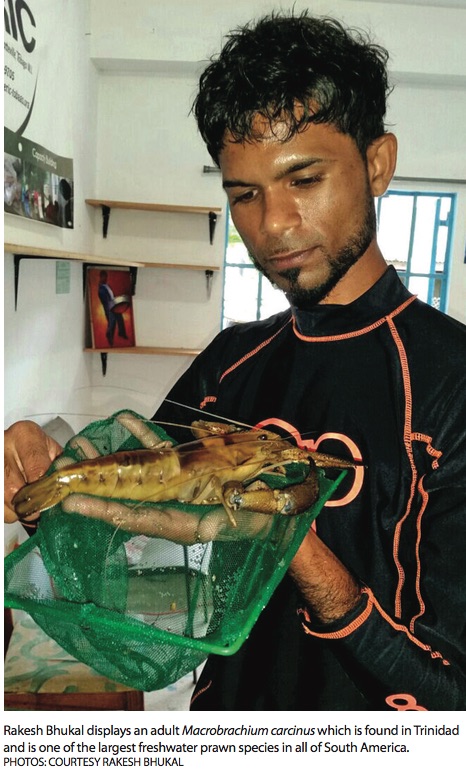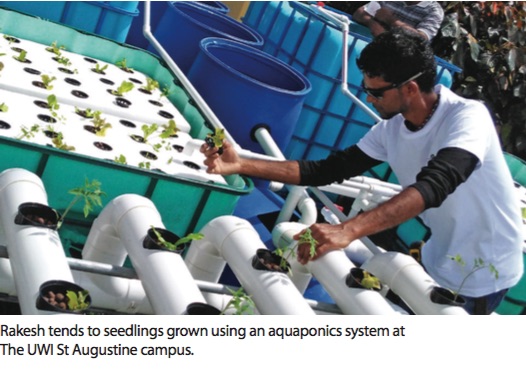Faculty of Food and Agriculture graduate student combines aquaculture and hydroponics to minimise waste and optimise for our tropical climate

As global fisheries and fish stocks continue to be affected by climate change, ecocide and overfishing, freshwater aquaculture has become one of the fastest growing practices in global food production.
Defined by the United Nations as the farming of aquatic organisms like fish and aquatic plants, aquaculture plays an increasingly crucial role in bridging the gap between a rising global demand for fish products and a declining global fish stock.
However, UWI St Augustine PhD student Rakesh Bhukal explains, the resources used and nutrient-rich wastewater generated by aquaculture cannot go unnoticed.
As he pursues his doctorate in Food Production at the Faculty of Food and Agriculture, Bhukal’s research focuses on the role aquaponics can play in minimising the waste generated by local aquaculture farms, and optimising these systems for the country’s tropical climate.
He explains, “Aquaponics is basically a combination of aquaculture and hydroponics (the cultivation of plants without soil) using wastewater from aquatic species. Aquaculture and hydroponics, on their own, are leading technologies all around the globe. So basically, it is a hybrid technology that utilises the best of both of these technologies.”
A large volume of water is used for aquaculture, and as this water recirculates in an aquaculture system, research has found there is a buildup of waste from the fish being cultivated. Traditionally, Bhukal says, this waste would have been released into the environment:
“What research has found is that the waste produced by fish in those recirculating aquaculture systems actually has an ideal nutrient composition for the growth of many different types of plants. The traditional approach of freely releasing the wastewater wasn’t only wasting nutrients, but it produced a significant environmental risk because nutrient-rich water gets into waterways and contributes to eutrophication (harmful algal blooms).”

Bhukal said the indiscriminate release of wastewater and consequential eutrophication is a problem with local aquaculture farms.
If aquaponics practices are applied to local farms, Bhukal believes the generated nutrient-rich wastewater can instead be diverted to hydroponic systems where present.
Farmers without hydroponics systems can set up these systems, where possible, which not only reduces their waste, but can help generate additional revenue if they begin growing crops alongside their aquaculture activities.
Hydroponic systems have become a widespread farming practice due to a global decrease in arable land due to climate change and accelerated land use change.
“This can also help to reduce the use of traditional synthetic fertilisers in hydroponic systems,” adds Bhukal. “The plant will use the nutrients in the wastewater for their growth and development.”
If executed properly, and proper filtering systems are developed, the FFA student says the filtered water can even be recirculated to the fish thanks and help reduce water use on aquaculture farms.
Apart from gaining an understanding of how these systems operate, Bhukal is also looking into optimising them to function effectively in Trinidad and Tobago’s tropical climate.
“In terms of the aquatic species for the aquaculture systems, I am now looking at local neotropical species in both fish and crayfish,” he says. “The advantages for looking into these types of species include the fact they are locally sourced, which eliminates the risk of an imported species being accidentally released and becoming invasive.”
From a conservation point of view, Bhukal says using aquaponics to grow local species which are commercially harvested can help protect the population of local fish stocks from further overfishing. Additionally, cultivating local fish also reduces the need for using imported feed and other inputs.
He explains that Macrobrachium carcinus, one of the largest neotropical freshwater prawn species in all of South America which is found in Trinidad, is a good species to cultivate using aquaponics. It is a local delicacy and fetches a very high price.

“One of the things I’m hoping to accomplish is to develop a backyard homestead aquaponics system which has an integrated variety of local aquatic species that can be cultivated together,” he says. “I want to run some nutrient profiles on them to know exactly what micronutrients they have to ensure these systems are built with the nutrition aspect of food security as well.”
Outside the classroom, Bhukal is already applying his knowledge to the real world, and assisting farmers with their aquaponic systems. An entrepreneur, he is the owner of a company called Aquatik Solutions, which specialises in aquaponics, hydroponics, and aquaculture.
“I would have informally done this over the years, but this is what led me to do my PhD research. The whole idea is to spread this work. I actually have models and production systems I would have designed and I have also done a lot of work directly with farmers,” he explains.
“I want to have a direct route to apply what the research will find on optimising these systems and putting it directly in the hands of farmers who need it,” adds the young aquaponics entrepreneur.
His work is not only about business. To further increase awareness of the systems, Bhukal has also offered his services free of charge to schools. So not only is he engaged in the pursuit of cultivating fish and plants. He’s also helping to cultivate the next generation of aquaponics practitioners.